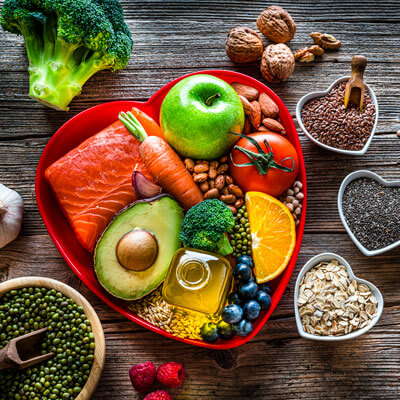Nutritional Supplementation at Cannon Chiropractic, PLLC

Patients suffering from chronic pain, disc issues and sciatica may have specific nutritional deficiencies that can cause or exacerbate the problem and impede healing. A nutritional eating program or supplementation (or both) may improve healing and help provide longer-lasting results. At Cannon Chiropractic, PLLC, nutritional support is part of our overall approach to helping you create optimal health.
NEW PATIENTS
Eat Right for Your Spine
Reducing toxins in your system is the first step. Eliminate alcohol, coffee, cigarettes, refined sugars and saturated fats, all of which are toxins and slow the healing process.
- Limit Sugar: Americans consume an average of 100 lbs of sugar each year! High-sugar diets generally lack nutrients needed to prevent the release of chemical irritants in the body. Desserts tend to be high in omega-6 fatty acids, which increase inflammation.
- Reduce Stress: Tension also negatively affects your health by triggering the release of stress hormones. It’s important to reduce the toxins you consume, but don’t stop there! Detoxify the rest of your life using simple, effective tools such as yoga, massage and meditation to reset your physical and mental reactions to the stress that daily life brings.
Add Superfoods
You can improve spinal health at the cellular level by eating “superfoods,” such as
- Shellfish: crab, shrimp, prawns and oysters
- Dark green vegetables: kale, spinach, collards, asparagus
- Red fruits and vegetables: red peppers, beets, stewed or fresh tomatoes, dark berries like blueberries and blackberries
- Black olives
- Red onions and apples
- Flaxseeds, chia seeds
- Beans: navy beans, kidney beans, soybeans, etc.
- Cold water oily fishes: anchovies, herring, sardines, salmon and mackerel
- Winter squash
- Olive oil
- Fruits, nuts, vegetables and grains
- Clear water: Keep yourself well-hydrated. Ideally, drink 8 10-ounce cups of clear water per day to give your body the water it needs to rehydrate cells in the healing process.
Foods to Avoid
There are also foods that it’s best to avoid, if you’re looking to optimize your health. Nitrates, sugars and fats can add fuel to the inflammation and pain associated with back pain. In general, it’s a good idea to avoid the following:
- Processed foods high in nitrates (hot dogs, sausage, lunch meats)
- Foods high in sugar, saturated and trans fats (deserts, cookies, cakes, fast food)
- Any foods containing high fructose corn syrup (salad dressing, soda)
Everything you eat or drink affects your health, either positively or negatively. Choosing wisely can help boost your body’s innate healing power.

Nutritional Supplements
It’s not always possible to naturally ingest the quality or quantity of nutrients that your body needs to heal and function optimally from food sources alone. The following are some supplements that we may recommend as part of your overall care plan:Multivitamin/Multimineral
Omega-3 (Fish Oil) for Joint Health
Bromelain: a Natural Anti-inflammatory
This herbal preparation has been used to treat many health complaints, including fever, headaches, inflammation, influenza, muscle pain and weight loss. It acts as an anti-inflammatory by blocking potentially inflammatory prostaglandins. White willow bark should not be used if you have a bleeding disorder or with blood-thinning medications. Before taking willow bark for your lower back pain, talk with your doctor about possible side effects and proper dosage.
Turmeric for Joint Pain and Stiffness
Several studies have shown that turmeric works as an anti-inflammatory and that it modifies the immune system. In a 2006 study, turmeric was more effective at preventing arthritis joint inflammation as opposed to reducing inflammation.
A study in 2009 compared extracts of turmeric with extracts of a related plant species, cucurma domestica, containing the same medicinal chemicals as regular turmeric. Researchers found that it worked as well at relieving symptoms of arthritis as 800 milligrams of ibuprofen daily. But definitive studies in humans are lacking, so the benefit of turmeric on arthritis is unclear.
People on blood thinners should use caution when taking turmeric as animal studies indicate it may increase the risk of bleeding. It may also cause stomach ache.
Drink Plenty of Water
- Daily water intake should be 1 ounce of water for every 2 pounds of your body weight. So if a patient weighs 200 lbs, then they should consume 100 ounces of water per day.
- The human body is more than 70% water. Water is needed in the function, repair, and growth of all avascular white tissues, including ligaments, cartilages, joints and spinal discs 1.
- Most patients with musculoskeletal problems are already dehydrated, and patients who age more rapidly than their years are often found to have a body composed of 50% water instead of the 70% 2.
- Water and Your Discs: There is no direct blood supply to the discs. At 12 to 14 years of age, the spinal discs’ blood nutrition supply and waste elimination system atrophies. 4,5 The intake of at least 64 ounces of water (or half the person’s body weight in ounces) is essential for nutrition delivery and waste elimination for spinal discs, ligaments, joints, and all body functions to perform at an optimal level. 1,6
- Each spinal disc nucleus contains 88% water. 4,7 75% of a person’s body weight is supported by the discs in the low back. If these discs lose water, they will lose height, which will subsequently shift the weight load from the discs to the posterior joints, ultimately leading to degenerative changes and bone spurring in the spinal canal.
Learn More Today
Contact us today to learn more about how nutritional support may be able to help you reach your health goals.
CONTACT US
References
1 Balch PA, Balch JF. Prescription for Nutritional Healing, 3rd edition. 2002 Avery New York
2 Broody TA. Alkalinize or Die. 1995 Portal Books California
6 Markoff KL, Morris JM: The structural components of the intervertebral disc. J Bone and Joint Surgery 1974; 56:141-154
7 Saulter F, Oglive-Harris D: Healing in inter-articular fractures and continuous passive motion 1994
